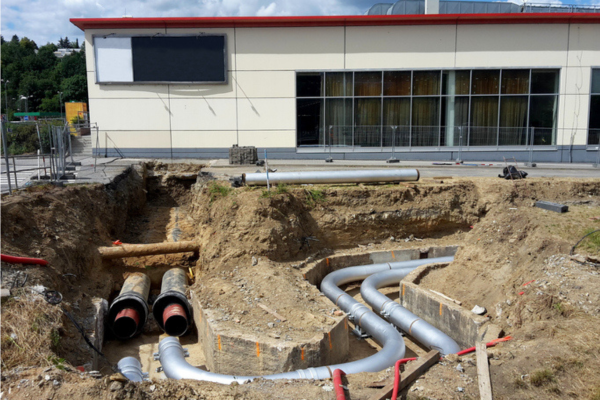
A geothermal system, also known as a ground source heat pump, uses stable underground temperatures to heat or cool a home and provide hot water. Pipes buried underground circulate a fluid that absorbs or rejects heat.
A heat pump then transfers that energy into the home for space heating, cooling or water heating. The ground acts as a thermal battery, improving efficiency and reducing reliance on gas or electric resistance systems.
Current regulations and industry direction
Geothermal systems must meet Australian plumbing and electrical standards and be installed by licensed trades. They are recognised under the National Construction Code as an efficient renewable heating and cooling option. As part of Australia’s move toward net zero emissions, government programs and energy ratings are increasingly encouraging the use of renewable technologies such as geothermal.
Geothermal systems can help homes achieve higher energy ratings such as NatHERS or Green Star. They also align with the growing trend toward sustainable building practices in renovations and new developments.
Why geothermal suits renovations
Geothermal systems are well suited to renovations that aim for energy efficiency and long‑term cost savings. They require space for underground pipework, so they work best for properties with suitable land for either vertical or horizontal loops. When combined with solar and battery storage, geothermal systems can further reduce running costs and carbon emissions.
While the initial installation cost is high, the systems often deliver significant savings over time. Many homes achieve reductions in heating and cooling energy use of 60 to 80 percent compared to traditional systems.
Types of geothermal systems
Open loop systems
Open loop systems use groundwater from an aquifer for heat exchange. They are efficient where suitable groundwater is available but must meet water quality and environmental regulations.
Closed loop systems
Closed loop systems circulate fluid through sealed pipes buried in vertical boreholes or horizontal trenches. They are the most common type for Australian homes as they have minimal environmental impact and suit a wide range of properties.
Hybrid systems
Hybrid designs combine geothermal with other technologies, such as integrating waste heat recovery to supply hot water or pairing with solar systems to maximise efficiency.
Benefits and considerations
Benefits
- High efficiency and low running costs
- Reduced reliance on gas or fossil fuels
- Provides both heating and cooling from one system
- Integrates well with solar and home energy management systems
- Long lifespan with low maintenance requirements
Considerations
- High upfront installation cost compared to conventional systems
- Requires adequate land or borehole access for ground loops
- Planning and site assessment are essential before installation
- Payback period depends on energy use, site conditions and energy tariffs
Installation tips for renovators
- Arrange site testing early to confirm soil conditions and available space
- Work with experienced designers and installers to size the system correctly
- Plan integration with solar PV and other energy‑efficient upgrades
- Ensure installation meets plumbing, electrical and building code requirements
- Design the system for ease of maintenance and long‑term access to components





